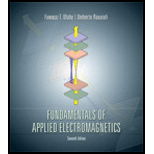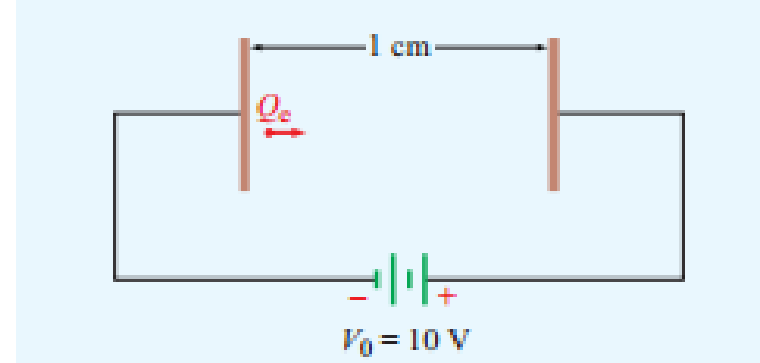
Fundamentals of Applied Electromagnetics (7th Edition)
7th Edition
ISBN: 9780133356816
Author: Fawwaz T. Ulaby, Umberto Ravaioli
Publisher: PEARSON
expand_more
expand_more
format_list_bulleted
Concept explainers
Textbook Question
Chapter 4, Problem 54P
An electron with charge Qe = −1.6×10−19 C and mass me = 9.1 × 10−31 kg is injected at a point adjacent to the negatively charged plate in the region between the plates of an air-filled parallel-plate capacitor with separation of 1 cm and rectangular plates each 10 cm2 in area (Fig. P4.54). If the voltage across the capacitor is 10 V, find the following:
- (a) The force acting on the electron.
- (b) The acceleration of the electron.
- (c) The time it takes the electron to reach the positively charged plate, assuming that it starts from rest.

Figure P4.54 Electron between charged plates of Problem 4.54.
Expert Solution & Answer
Want to see the full answer?
Check out a sample textbook solution
Students have asked these similar questions
In Fig.35 resistive loads, 1, 2, and 3, respectively, absorb 1200 W, 2400 W, and 3600 W. Calculate the current:
a. In lines A and B.
b. In the neutral conductors.
c. In the HV line.
+
-ww
I
2
12V
2
Determine I, I,, I₂ and V₁
1 _< +
www
5 12
16
6
5
www
Determine (a) the average and (b) rms values of the periodiccurrent waveform shown in Fig. P8.9
Chapter 4 Solutions
Fundamentals of Applied Electromagnetics (7th Edition)
Ch. 4.2 - What happens to Maxwells equations under static...Ch. 4.2 - How is the current density J related to the volume...Ch. 4.2 - Prob. 3CQCh. 4.2 - A square plate residing in the xy plane is...Ch. 4.2 - A thick spherical shell centered at the origin...Ch. 4.3 - When characterizing the electrical permittivity of...Ch. 4.3 - If the electric field is zero at a given point in...Ch. 4.3 - State the principle of linear superposition as it...Ch. 4.3 - Four charges of 10 C each are located in free...Ch. 4.3 - Two identical charges are located on the x axis at...
Ch. 4.3 - In a hydrogen atom the electron and proton are...Ch. 4.3 - An infinite sheet with uniform surface charge...Ch. 4.4 - Explain Gausss law. Under what circumstances is it...Ch. 4.4 - How should one choose a Gaussian surface?Ch. 4.4 - Two infinite lines, each carrying a uniform charge...Ch. 4.4 - A thin spherical shell of radius a carries a...Ch. 4.4 - A spherical volume of radius a contains a uniform...Ch. 4.5 - What is a conservative field?Ch. 4.5 - Why is the electric potential at a point in space...Ch. 4.5 - Prob. 11CQCh. 4.5 - Why is it usually easier to compute V for a given...Ch. 4.5 - Prob. 13CQCh. 4.5 - Determine the electric potential at the origin due...Ch. 4.5 - A spherical shell of radius a has a uniform...Ch. 4.6 - What are the electromagnetic constitutive...Ch. 4.6 - Prob. 15CQCh. 4.6 - What is the conductivity of a perfect dielectric?Ch. 4.6 - Prob. 17CQCh. 4.6 - Prob. 18CQCh. 4.6 - Determine the density of free electrons in...Ch. 4.6 - Prob. 13ECh. 4.6 - A 50 m long copper wire has a circular cross...Ch. 4.6 - Prob. 15ECh. 4.7 - What is a polar material? A nonpolar material?Ch. 4.7 - Prob. 20CQCh. 4.7 - What happens when dielectric breakdown occurs?Ch. 4.7 - Find E1 in Fig. 4-19 if E2=x2y3+z3(v/m),1=20,2=80,...Ch. 4.7 - Repeat Exercise 4.16 for a boundary with surface...Ch. 4.8 - What are the boundary conditions for the electric...Ch. 4.8 - Prob. 23CQCh. 4.9 - How is the capacitance of a two-conductor...Ch. 4.9 - What are fringing fields and when may they be...Ch. 4.10 - To bring a charge q from infinity to a given point...Ch. 4.10 - Prob. 27CQCh. 4.10 - The radii of the inner and outer conductors of a...Ch. 4.11 - What is the fundamental premise of the image...Ch. 4.11 - Given a charge distribution, what are the various...Ch. 4.11 - Use the result of Example 4-13 to find the surface...Ch. 4 - A cube 2 m on a side is located in the first...Ch. 4 - Prob. 2PCh. 4 - Find the total charge contained in a round-top...Ch. 4 - If the line charge density is given by l = 24y2...Ch. 4 - Find the total charge on a circular disk defined...Ch. 4 - If J = 4xz (A/m2), find the current I flowing...Ch. 4 - Prob. 7PCh. 4 - An electron beam shaped like a circular cylinder...Ch. 4 - Prob. 9PCh. 4 - A line of charge of uniform density occupies a...Ch. 4 - A square with sides of 2 m has a charge of 40 C at...Ch. 4 - Three point charges, each with q = 3 nC, are...Ch. 4 - Charge q1 = 6 C is located at (1 cm, 1 cm, 0) and...Ch. 4 - A line of charge with uniform density = 8 (C/m)...Ch. 4 - Prob. 15PCh. 4 - A line of charge with uniform density l extends...Ch. 4 - Repeat Example 4-5 for liie circular disk of...Ch. 4 - Multiple charges at different locations are said...Ch. 4 - Three infinite lines of charge, all parallel to...Ch. 4 - Prob. 20PCh. 4 - A horizontal strip lying in the xy plane is of...Ch. 4 - Prob. 22PCh. 4 - Prob. 23PCh. 4 - Charge Q1 is uniformly distributed over a thin...Ch. 4 - The electric flux density inside a dielectric...Ch. 4 - Prob. 26PCh. 4 - An infinitely long cylindrical shell extending...Ch. 4 - If the charge density increases linearly with...Ch. 4 - A spherical shell with outer radius b surrounds a...Ch. 4 - Prob. 30PCh. 4 - Prob. 31PCh. 4 - A circular ring of charge of radius a lies in the...Ch. 4 - Prob. 33PCh. 4 - Find the electric potential V at a location a...Ch. 4 - For the electric dipole shown in Fig. 4-13, d = 1...Ch. 4 - For each of the distributions of the electric...Ch. 4 - Two infinite lines of charge, both parallel to the...Ch. 4 - Given the electric field E=R18R2(V/m) find the...Ch. 4 - An infinitely long line of charge with uniform...Ch. 4 - The xy plane contains a uniform sheet of charge...Ch. 4 - A cylindrical bar of silicon has a radius of 4 mm...Ch. 4 - Repeat Problem 4.41 for a bar of germanium with e...Ch. 4 - A 100 m long conductor of uniform cross-section...Ch. 4 - Prob. 44PCh. 4 - Apply the result of Problem 4.44 to find the...Ch. 4 - A 2 103 mm thick square sheet of aluminum has 5 cm...Ch. 4 - A cylinder-shaped carbon resistor is 8 cm in...Ch. 4 - With reference to Fig. 4-19, find E1 if...Ch. 4 - An infinitely long cylinder of radius a is...Ch. 4 - If E=R150(V/m) at the surface of a 5-cm conducting...Ch. 4 - Figure P4.51 shows three planar dielectric slabs...Ch. 4 - Determine the force of attraction in a...Ch. 4 - Dielectric breakdown occurs in a material whenever...Ch. 4 - An electron with charge Qe = 1.61019 C and mass me...Ch. 4 - In a dielectric medium with r = 4, the electric...Ch. 4 - Prob. 56PCh. 4 - Prob. 57PCh. 4 - Prob. 58PCh. 4 - Prob. 59PCh. 4 - Prob. 60PCh. 4 - Prob. 61PCh. 4 - Conducting wires above a conducting plane carry...Ch. 4 - Prob. 63P
Knowledge Booster
Learn more about
Need a deep-dive on the concept behind this application? Look no further. Learn more about this topic, electrical-engineering and related others by exploring similar questions and additional content below.Similar questions
- Repairs have to be carried out on HV cir- cuit breaker No. 6 shown in Fig. 26. If the three 220 kV lines must be kept in service, which disconnecting switches must be kept open?arrow_forwardFind the voltage v(t) for t>=0 show all steps and redraw circuit as necessary, the switch closes at t=0 and v(t) is the voltage over the 4ohm resistor as shown in the circuit.arrow_forwardFind the voltage v(t) for t>=0 please redraw circuit as necessary and show all steps.arrow_forward
- Determine (a) the average and (b) rms values of the periodiccurrent waveform shown in Fig. P8.9arrow_forwardFind Eigenvalues and Eigenvectors for the following matrices: [5 -6 1 A = 1 1 0 3 0 1arrow_forwardUse Gauss-Jordan Elimination method to solve the following system: 4x1+5x2 + x3 = 2 x1-2x2-3x3 = 7 3x1 x2 2x3 = 1. -arrow_forward
- 3. As the audio frequency of Fig. 11-7 goes down, what components of Fig. 12-4 must be modified for normal operation? OD C₂ 100 HF R₁ 300 Re 300 ww 100A R 8 Voc Rz 10k reset output 3 R7 8 Voc 3 reset output Z discharge VR₁ 5k 2 trigger 2 trigger 7 discharge R 3 1k 5 control voltage threshold 6 5 control voltage 6 threshold GND Rs 2k C. C. 100 GND Uz LM555 1 Ce 0.01 U, LM555 0.01 8.01.4 PRO Fig. 11-7 Audio lutput Pulse width modulator R4 1k ww C7 Re 1k ww R7 100 VR 50k 10μ Ra R10 C₁. R1 3.9k 3.9k 0.14 100k TO w Rs 51 82 3 H 10 Carrier U₁ Ca Input A741 2.2 Us MC1496 PWM signal input R2 0.1100k Uz A741 41 Cs 1 Re 10k VR2 50k VR3 100k 14 12 C3. 3% + Ce 0.1 10μ 5 1A HH C +12V 0.1 O PWM Output C 0.02- R 100k +12 V Demodulated output 6 Ca 0.33 w R 10k R12 100k ww 31 о + 4A741 -12 V Fig. 12-4 PWM demodulator C 1500parrow_forwardDUC 1. In Fig. 12-4, what are the functions of the VR1 and VR2? 2. In Fig. 12-4, what is the function of the VR3? VR₁ 50k C₁ R1 0.1 100k Carrier Input U₁ A741 PWM signal input R41k www Re 1k w C7 ± 10μT R7 100 ww =L H C4 2.2 H W82 Rs 51 3 10 U3 MC1496 C2 R2 U2 A741 22 0.1 100k VR2 50k VR3 100kr 14 C3 10μ 1k 0.1 4 5 6 12 m Re 10k R9 R102 3.9k 3.9k HHI C10 0.1 -0 +12V C11 R 0.02 100k +12 V Demodulated output C R11 R12 A741 0.33 10k 100k -12 V Ca 1μ C12 1500p PRODUC Fig. 12-4 PWM demodulator PRODUCTSarrow_forward10.37 Use mesh analysis to find currents I₁, I2, and I3 in the circuit of Fig. 10.82. ML 120-90° V 120 -30° V Figure 10.82 For Prob. 10.37. N N Z=80-135arrow_forward
- 3. Find the phasor current I。 in the circuit shown below. Be aware of the direction markings. (15 pts) 1052 I 5057 ①520 Amps 2012 j5052arrow_forward10.93 Figure 10.135 shows a Colpitts oscillator. Show that the ed oscillation frequency is 1 fo= 2π √√LCT where CTC₁C2/(C₁ + C₂). Assume R; >>> R₁ + Rf ww Vo L m C₂ C₁ 5 Xci Figure 10.135 A Colpitts oscillator; for Prob. 10.93. (Hint: Set the imaginary part of the impedance in the feedback circuit equal to zero.)arrow_forwardDetermine (a) the average and (b) rms values of the periodiccurrent waveform shown in Fig. P8.3.arrow_forward
arrow_back_ios
SEE MORE QUESTIONS
arrow_forward_ios
Recommended textbooks for you
 Delmar's Standard Textbook Of ElectricityElectrical EngineeringISBN:9781337900348Author:Stephen L. HermanPublisher:Cengage Learning
Delmar's Standard Textbook Of ElectricityElectrical EngineeringISBN:9781337900348Author:Stephen L. HermanPublisher:Cengage Learning

Delmar's Standard Textbook Of Electricity
Electrical Engineering
ISBN:9781337900348
Author:Stephen L. Herman
Publisher:Cengage Learning
Capacitors Explained - The basics how capacitors work working principle; Author: The Engineering Mindset;https://www.youtube.com/watch?v=X4EUwTwZ110;License: Standard YouTube License, CC-BY